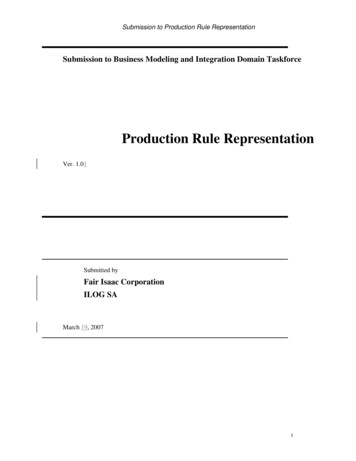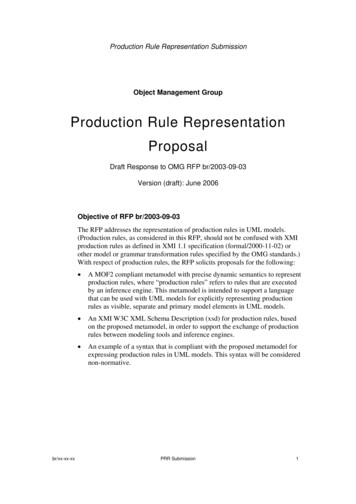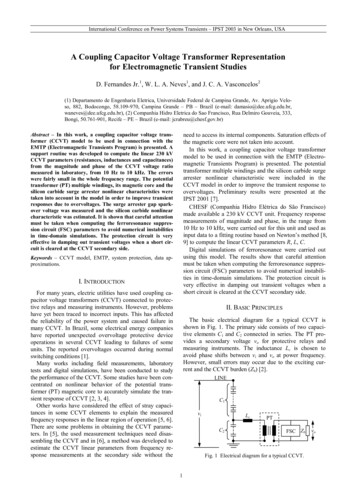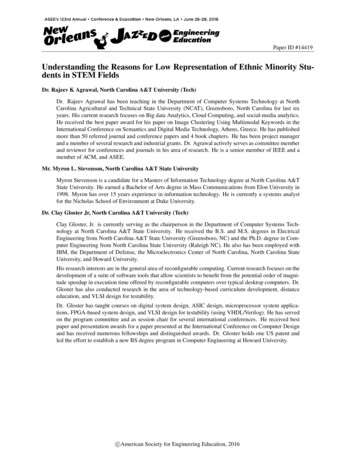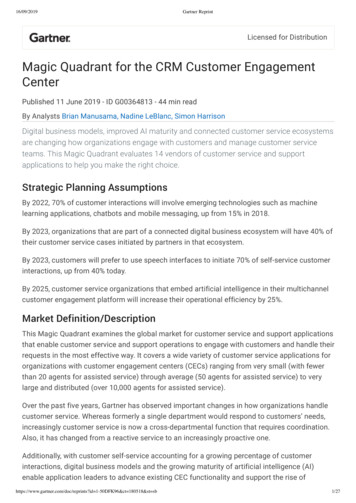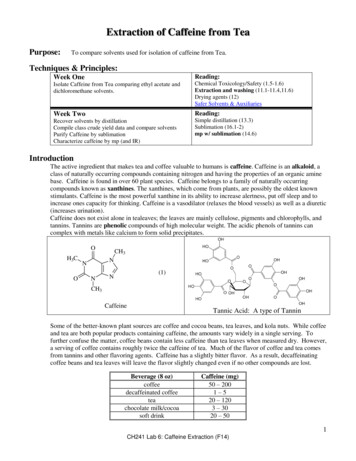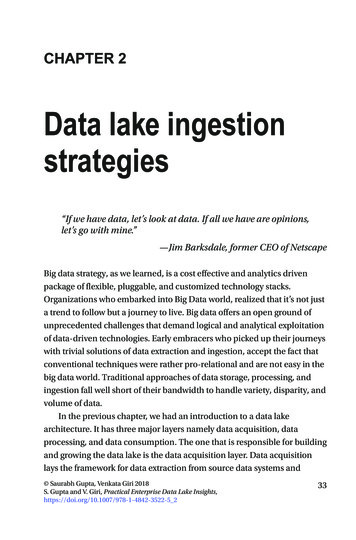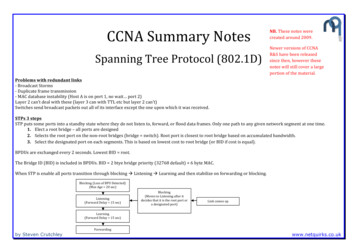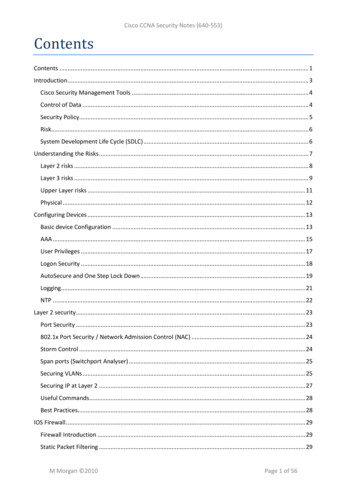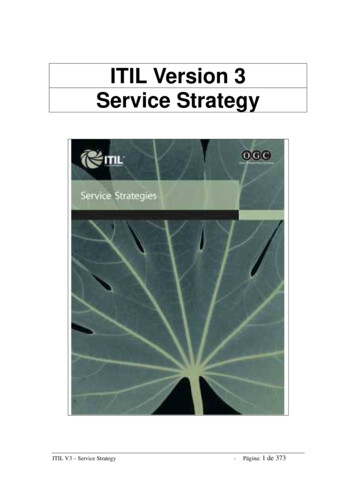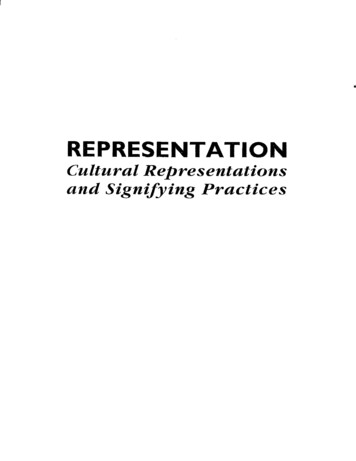
Transcription
REPRESENTATIONCultural Representationsand Signifying Practices
Culture, Media and IdentítiesThe Open UniversifyCourse TeamCJaire Alexander, Criücal readerMaggie Andrew, Tutor panelmember, Study Guide autihorMelanie Bayley, EditorVerónica Beechey, Critical readerRobert Bocock, AuthorDavid Bosweli, Critical readerPeter Braham, AuthorDavid Calderwood, ProjecícontrollerElizabeth Chaplin, Tutor panelmember, Study Guide auííiorLene Connolly, Print buyragcontrollerJeremy Cooper, BBC producerMargare! Dickens, Print buyingco-ordinatorjessiea Evans, Critical readerMartin Feras, EditorPaul du Gay, Book I Chair,Book 4 Chair, AuthorRuth Finnegan, AuíhorStuart Hall, Course Chair,Book 2 Chair, AutihorPeter Hamüton, AuthorJonathan Huni, CupublishingadvisorLinda Janes, Course naanagerSián Lewis, Graphic designarHugh Mackay, Book 5 Chair,AuthorDavid Morley, GoídsmiíhsCollege, Universiíyof London,Exíernal assessorLesley Passey, Cover designerClive Pearson, Tutor panelmember, Síudy Guide authorPeier Redman, Tutor panelmember, Siudy Guide authorGraeme Salaman, ÁuthorPaul Smiíh, Media libraríanKeaaeth Thompson, Book 6Chair, AuthorAlisan Tudker, BBC seriesproducerPauline Tutaer, Couxse secretaryKathrya Woodward, Book 3Chair, AuthorChris Wooldridge, EditorConsultant authorsSusaa Beíison, Univfírsity ofCambridgePaul Gilroy, Goldsniiífas Colige,Universiíy of LondoaChristíae Gledhill, SlaffordshíFeUniversityHenrietta Lidchi, Museum oíMankind, LondonDaniel Miller, Uaiversity ofLondonShatm Moores, Queea MargaretCollege, EdiaburghKeiíh Negus, Uníversiíy ofLeicesterSean Nixon, Uaiversíty of EssexBhikhu Parekh, University ofHullKevin Robins, Universiíy ofNewcastle upon TyneLyime Segal, MiddlesexUniversiíyChris Shillmg, University ofPortsmouthMigel Thrift, University of BristolJohn Tomlinson, NottinghamTrent UniversiíyThts book is part of theCulture, Medio and fdentitiesseries published by Sagein associatíon wiíhThe Open University.Doing Cultural Sluáies:The Storyofthe Sony Walknmnby Paul du Gay, Stuart Hall,Linda Janes, Hugh Mackay andKeith NegusEspresentation:Cultural Representations andSignifying Practicesedited fay Stuart HaiiIdentity and Differenceedited by Kathryn WoodwardProducüon of Culture/CulturesofPfoductionedited by Paul du GayConsumptíon and Eveiyday Láfeedited by H«gh MackayMedia and Cultural Regulationedited by Kermeth ThompsonThe final fbrai of the text is thejoiiitresponsibilily of chapterauthors, book editors and courseteam commentaíors.The books are parí of TheOpea Universiiy course D318Culture, Media and Identities.Details of this and oíher OpenUniversiíy courses can beobteined from ihe CourseReservatíons and Sales Centre,PO Box 724, The OpenUniversity, Millón KeynesMK7 6ZS. For avaitability ofoíher course components,iacludisg video- and audiocassette laateriais, contactOpen University EducationaiEnterprises Lid, 12 CofferidgeCióse, Stony Stratford, MiííonKeynes MK11 1BY.
SAGE PublicationsLondon*Thousand Oaks»Mew Delhiin association withTheOpenUniversjíy9REPRESENTATIONCultural Representationsand Signifying PracticesEd/ted by STUART HALL
The Qpen University, Walton Hall, Milton Keynes MK7 6AÁ The Qpen-University 1997First published m 1997Repraaied 1998,1999, 2000, 20Q1, 2002 (twice), 20Q3, 2007. 2009The opinions expressed are nal necessaiily tíaose oí íhe Course Team or of The OpenUniversiíy.All rights reserved. No part of this publicatíoQ may be reprodueed» stored in a retrievaísystem, tran mitted or utilizad in any fonn or by any meaos, eleeíromc, mechaiiicaí,photocopying, recording or otherwise, withoiit permission in wrJting from thePubiishers,SAGE Publications Ltd6 Bonhill StreetLondon EC2Á 4PUSAGE Publications Inc.2455 Teller RoadThousand GaksCalifornia 91320SAGE Publications India Pvt Ltd32, M-Block MaricetGreaíer Kailash -1NewDelhillGÍMSBritish lábrary Catalog«iíi§ in Publicatíon dataA catalogue record for tb.is book is available froia The Britísh Library.ISBN O 7619 5431 7 {cased)ISBN O 7619 5432 5 (pbk)Library of Congress caíalog card number 96-071228Edited, designed and typeset by The Opea Universíty,ftiated ÍH Qre t iritaia % Ssotpidbat
REPRESENTATION:CULTURAL REPRESENTATIONSAND SIGNIFYING PRACTICESedfeed by Síuart HallIntroduction*IChapter ITHE WORK OF REPRESENTARON Stuan Hotf13Cbapter 2REPRESENTING THE SOCIAL FRANCE ANDFRENCHNGSS IN POST-WAR HUMANSSTPHOTOGRAPHY Peíer HomOton75Chapter 3 THE POETICS AND THE POUTSCS OF EXHiBiTINGOTHER CULTURES Henrieíío Udchi15 1Chapter 4 THE SPECTACLE OF THE "OTHER' Síwafí Hafl223Chapter 5 EXHIBITING HASCULINITY Sean Nófon29!Chapter 6 GENRE AND GENDER: THE CASE OF SOAP OPERAChrístine QedhsM337Acknowledgements387Index391
IntroductionSíwarí H&llThe chapters in this volume ail deal, in difieren!; ways, with the quesíion ofrepreseníation. This is eme of the central practices which produce cultureand a key "moinent' in whaí has been called the 'circuit of culture' (see dwGay, Hall el al.» 1997*). But what does represeníation have to do with'culture'; whaí is the conaeetioe beíween them? To put ií sinaply, culture isabouí "shared meanings*. Now, ianguage is íhe privileged médium in whichwe 'make sense* of íbings, in which meaning is produced and exchanged.Meanings can oaly be shared íhiough our common access to Ianguage. SoIanguage is central to meaning and culture and has always been regarded asthe key repository of cultural valúes and meanings.The circuit ofculturep*productionBut how does Ianguage constarací meanings? How does it sustain íhedialogue between participanís which eaables theim ío build up a culture oíshared undersíandings and so inteipret the world in roughly the same ways?Language is able to do this because it operates as a representatíonal system.In Ianguage, we use signs and synibols — whether íhey are sounds, writtenwords, electronically produced images, musical notes, even obfects - tostand for or represent ío other people our concepts. ideas and feelings.Language is one of íhe 'media' through which thoughís, ideas and feelingsare representad in a culture, Representaíion íhxough Ianguage is íhereforecentral to the processes by which meaniog is produced. This is the basic,underlying idea which underpins all six chapters in this book. Each chapíerexamines "the productioe and circulaíion of meaning through Ianguage' indifferení ways, in relation to different examples, differení áreas of socialA reference in bo!d índícates another book, or auother chapíer in anoíher book. in íhe series.
2REPRESENTATIQN: CULTURAL REPRESENTATSONS AND SiGNiFYíNG PRACTICESpractice. Together» these chapters push forward and develop ourunderstanding of how representation actually works.'Culture' is one of tb.8 most diffieult concepts in íhe human and social sciencesand there are many differení ways of defíning it. In more traditionaldefinitions of the tema, culture is said to embody the 'besí that has beenthought and said' in a society. ¡1 is the sum of the great ideas, as representad iníhe classic works of literature, painting, music and philosGphy—the 'highculture* oían age. Belonging to the same frame of reference, but more 'modero'in its assoeiations, is the use of 'culture' to refer to the widely distributedforms of popular niusic, publishing, arí, design and iíteraíure, or íhe activitiesof leisure-time and entertainmení, which make up the everyday lives of themajority of'ordinary people' — whaí is calleo! the 'mass culture' or the 'popularculture' of an age. High culture versus popular cuitare was, for many years,the classic way of framing the debate about culture - the lerms carryiiig apowerfully evaiuatíve charge (roughly, high good; popular debased). Inrecent years, and in a more 'social science* coatexí, the word 'culture' is usedto refer ío whaíever is distinctive about the "way of life* of a people,coraxmmity, nation or social group. This has come to be known as the'anthropological' definitíon. Altematively, íhe word can be used to describeíhe 'shared valúes' of a group or of society - which is like the aníhropologicaldefinition, only wiíh a more sociológica! emphasis. You wiD find traces of allthese meanings somewhere in this book. However, as its title suggests,'culture' is usually being used in these chapíers in a somewhat different,more speeialized way.What has come to be called íhe 'cultural turn' in the social and humansciences, especiaíly in cultural studies and íhe sociology of culture, hastended to emphasize the importance ofmeamng to the definiiion of culture.Culture, it is argued, is not so mueh a set of things - novéis and paintings orTV prográmales and comics - as a process, a set ofpractíces. Primarily,culture is concerned wiíh the producíion and the exchange of meanings - the'giving and taking of meaning* — between the members of a socieíy or group.To say thaí two people belong to íhe same culture is io say íhat they interpreííhe woríd in roughly íhe same ways and can express themseives, theirthoughís and feelings abouí íhe world, in ways which wül be understood byeach other. Thus culture depends on its participanís interpretingmeaningrully what is happening around them, and "making sense' of íheworld, in broadly similar ways.This focus on 'shared meanings' may sometimes make culture sound toouniíary and too cognitíve. ín any culture, there is always a great diYersity ofmeanings about any topic, and more than one way of iaíerpreting orrepresenting it. Aiso, culture is abouí feelings, atíachmenís and emotíons aswell as concepts and ideas. The expression on my face 'says something' abouíwho I am (identity) and what I am feeling (emotions) and whaí group I feel Ibelong to íatíachment), which can be *read' and understood by oíher people,even if I didn't iníend deliberateiy to eoinmunieate anything as formal as 'a
JNTRODUCTiON3inessage', and even if the oíher person couldn'í gíve a very lógica! account ofhow s/he carne to understand what I was 'saying*. Above all, culturalmeanings are noí only 'ira the head', They organíze and regúlate socialpractices, iaflueace our conduct and consequentíy faave real, pracücaleffects.The emphasis on cultural practices is importan!. It is participante in a culturewho give meaning to people, objecís and events. Things 'in themselves'rareíy if ever have any onet single, fíxed and unchangíng meanmg. Evensomethíng as obvíous as a stone cao be a stone, a boundary marker or a pieceof sculpíure, depending on what it meams - that ís, wiíbin a certain context ofuse, within what the phüosaphers cali different 'language games' (i.e. íhelanguage of boundaries, the language of sculpture, and so on). It is by our useof things, and what we say, think and feel about íhem - how we represenííhem - that we gíve tkem a meaning. la part, we give objects, people andevenís raeaning by the fraitteworks of interpretation which we bríng ío íhem.In part, we give things raeaning by how we use them, or intégrate them míoour everyday praetices. It is our use of a pile of bricks and mortar whichmakes it a ehousef; and what we feel, think or say about it that inakes a 'house'a 'home'. In part, we give things meaning by how we represent íhem - thewords we use about thein, íhe sienes we teli abouí íhem, the images of themwe produce, íhe emoíions we associate with íhem, the ways we classify andconceptualize them, the valúes we place on them. Culture, we inay say, isinvolved in all those praeíices which are not simply geneticaily progranimedinto us - iike the Jerk of the knee when íapped - but which carey meaningand valué for us, which need to be mecuningfuilymterpFetedby others, orwhich depend on meaning for their effective operation. Culture, in this sense,perineaíes all of society. It is whaí distinguishes the 'human* elemení in socialUfe from what is simply biologicaíly driven. Its study underiines the crucialrole of the symbolic doinain at íhe very heart of social life.Where is meaning produced? Our 'circuií of culture* suggesís that, in fact,meanings are produced at severa! different sites and circulaíed íhroughseveral difieren! processes or practices (the cultural circuit), Meaning is whatgives us a sense of our own ideníiíy, of who we are and with whom we'belong' — so it is tied up with questions of how culture is used to mark outand mainíain identity witbin and differeace between groups (which is themain focus of Woodward, ed., 1997). Meaniag is constantly being producedand exchanged in every personal and social interactíon in which we takeparí. In a senae, íhis is the most privileged, though citen íhe most neglecíed,site of culture and meaning. It is also produced in a varieíy of differentmedia; especialíy, these days, in íhe modem mass media, íhe means of globalcommunicatíon, by complex techaologies, which circuíate meanings beíweendifferení culíures OH a scale and wiíh a speed hitherto unknown in history.(This is the focus of OH Gay, ed., 1997.) Meaning is also produced wheneverwe exprese ourselves in, make use of, consume or appropiiaíe cultural'íhings'; thaí is? when we incorpórate them in differení ways into the everydayrituals and practices of daily life and in íhis way give them valué or
4REPRESENTATSON: CULTURAL REPRESENTATiGNS AND SIGNIFY1NG PRACTICESsignificanee. Or when we weave narratives, stories — and fantasías — aroundthem. (This is the focus of Mackay, ed., 1997.) Meanings also regúlate andorganize our conduct and practicas — íhey help to set the rules, norms andconveníions by wMch social life is ordered and goveraed, They are also,therefore, what íhose who wish to govem and regúlate the conduct and ideasof others seek ío stracture and shape, (Tbis ís the focus of Tfeoaapson, ed.,1997.) In other words, the question of meaning arises in relation to all íhedifferent moments or practices in our 'cultural eireuif - in the constractionof idetóity and the marking of dííference, in production and consumption, aswell as in íhe regulaíion of social conduct. However, in all these instances,and at ail these differení institutional si
Gay, Hall el al.» 1997*). But what does represeníation have to do with 'culture'; whaí is the conaeetioe beíween them? To put ií sinaply, culture is abouí "shared meanings*. Now, ianguage is íhe privileged médium in which we 'make sense* of íbings, in which meaning is produced and exchanged. Meanings can oaly be shared íhiough our common access to Ianguage. So Ianguage is central to .
